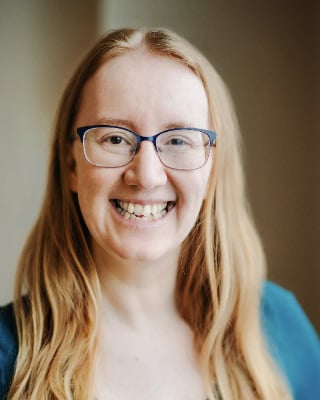An Interview with Diana Skrzydlo
By Expanding Horizons Editors
Expanding Horizons, November 2024

Expanding Horizons recently had the opportunity to interview Diana Skrzydlo, the winner of the Society of Actuaries’ (SOA’s) inaugural 2024 Outstanding Educator Award.

Expanding Horizons (EH): Can you tell us a bit about your background and how you became interested in actuarial science?
Diana Skrzydlo (DS): As a high school student I had never heard of actuarial science, but I knew I loved math. When I applied for math at the University of Waterloo, there was a scholarship sponsored by an insurance company for students intending to major in actuarial science, so I thought I would give it a try. I ended up liking the program and sticking with it (and adding a minor in music for fun!).
EH: What inspired you to pursue a career in education within the actuarial field?
DS: Through my co-op experiences in a few actuarial positions, I enjoyed the work but didn’t really find a place that fit me. Then for one co-op term I took a job as a computer science instructional support assistant (undergraduate teaching assistant [TA]) and absolutely loved it! I knew teaching was the place for me. I then went to graduate school in 2006 where I loved being a TA most of all. Immediately after completing my master’s degree, I started as a sessional instructor, teaching three courses in introductory probability and intro to proofs in fall 2007.
EH: What has been your career path leading up to winning the SOA Educator Award?
DS: Since my first term teaching went well, I was hired full time as a lecturer in the Statistics and Actuarial Science department in 2008 and have been there ever since. In 2016 I became a continuing lecturer. Since then I have taken on a mentorship role for new faculty members and graduate students, been the director of the Masters of Actuarial Science program, and am currently the Math Faculty Teaching Fellow.
EH: How would you describe your teaching philosophy?
DS: My teaching philosophy encompasses four beliefs: making material relevant, forging connections, desiring student success and promoting social responsibility. I try to embody these beliefs through my instructional strategies and assessment techniques. Whether it’s bringing in my actual car loan documents so we can validate the interest payment, talking about the probabilities involved in students’ favorite video games or letting students choose the topic of their projects, I want to connect the material to what students care about and give them agency to demonstrate their knowledge.
EH: What innovative teaching methods or approaches have you implemented in your courses?
DS: Some teaching strategies I have employed include in-class polling questions, regular think-pair-share activities, “think like an actuary” discussions, a LEGO communication activity, full class debates, “jigsaw” peer learning activities, inquiry-based learning and flipped classrooms. I also use a wide variety of assessments, including oral exams, summarizing presentations, projects, reflective questions on assignments, bonus YouTube videos, communication-focused questions that test high levels of learning, and authentic tasks such as creating/documenting spreadsheets. I’m also always looking for new things to try!
EH: How do you stay current with the latest developments in actuarial science and incorporate them into your teaching?
DS: I love coming to the Actuarial Research Conference (ARC) and seeing what research people are up to, even though I don’t do disciplinary research myself. I also teach a course on actuarial risk management where students choose presentations from a recent SOA meeting and summarize them for the class. Then I incorporate the concepts into my own teaching.
EH: Can you share some examples of how your work has positively impacted your students or the actuarial community?
DS: For my own students, I invest deeply in their personal and professional growth, and I have helped many students over the years find jobs and success. I don’t know if you can find a Canadian insurance company that doesn’t have one of my students working at it. I believe I have helped the actuarial community by sharing what I do and freely allowing others to use my resources. I am thrilled when my ideas are used by others to help even more students learn.
EH: What do you consider your most significant contribution to actuarial education?
DS: Probably my mentorship of other actuarial educators relating to aligning assessment and learning goals. I’ve given many talks over the years and encouraged other educators to teach and test higher levels of learning, communication skills, ethics and the nuance of actuarial work.
EH: How do you measure the success and effectiveness of your teaching methods?
DS: When I try an innovative teaching practice, I collect data on how students do in my course and in the courses that follow. For example, when I introduced computer science (CS) examples into an introductory probability course, the achievement gap between CS and non-CS students went from over 4% to less than 1%. When flipping a third-year probability models course, the students’ grades on exams and in the follow-up course both improved. A lot of success in terms of how people feel about math and their learning process can’t be measured easily, but I also think it’s important that students feel supported.
EH: What are some of the biggest challenges you face as an educator in the actuarial field?
DS: The biggest challenge for me is there are just not enough hours in the day to do all the teaching innovations I want to try and share them with others so they can benefit too!
EH: How do you address different learning styles and ensure all students grasp complex concepts?
DS: I am a big fan of Universal Design for Learning—recognizing that one size does not fit all and providing multiple means for students to engage and connect with content and demonstrate evidence of their knowledge. Employing inclusive teaching strategies can help. For example, if there is a project in a course with a presentation, I will give students the option to do an in-person presentation or a prerecorded video. I also build flexibility into my course design by using slip days or dropping the lowest assignment grade.
EH: What opportunities do you see for the future of actuarial education?
DS: I would love to see greater connection between industry and the classroom in both directions: bringing industry experiences to students through case studies or capstone projects, and providing more teaching/academic support to industry professionals who teach courses.
EH: Who have been your role models or mentors in your career, and how have they influenced you?
DS: Mary Hardy was a huge influence on me as a teacher and as a person. I admire how she always fights for equity, uplifts others’ voices and helps us understand the importance of the work actuaries do to serve the good of the public. Steve Furino was also an influential teacher; he showed me how to engage learners and lead them to discover things on their own rather than just tell them, a technique I frequently use.
EH: What advice would you give to aspiring actuaries and future educators in the field?
DS: Don’t be afraid to incorporate real stories and data into your teaching and ask students deep questions. It’s a lot messier, but that’s more realistic for actuarial work. In almost any actuarial course you can talk about climate change, ethical practice, external forces and so on.
EH: How do you balance your teaching responsibilities with your personal life and professional development?
DS: I try to have interests outside of work and stay connected with family and friends. I recently directed a play (a comedy musical) with a local community theater, which was a blast!
EH: What does winning the SOA Educator Award mean to you personally and professionally?
DS: It is an enormous honor to be the first recipient of this award. I am proud to be a member of the actuarial educator community, and every time I meet people, I’m inspired by the great work they are doing, so it is amazing to be recognized for also inspiring others.
EH: What are your future goals and aspirations in actuarial education?
DS: Greater inclusion and accessibility for students from a wider variety of backgrounds. I hope the actuarial profession can reflect the diversity of the public it serves.
EH: How do you think the role of actuarial educators is evolving in today’s rapidly changing world?
DS: Educators need to prepare our students for the future of work and technology. Teaching students to be flexible, ethical problem-solvers and critical thinkers will be more valuable than teaching them how to follow rote procedures.
EH: What role do you believe actuarial science plays in addressing global challenges, and how can education contribute to this?
DS: Actuaries have a huge role to play in the management of global risks such as climate change, cyber risk and equity. I think it’s important for students at all levels to consider the far-reaching consequences of actuarial work and how external factors can affect it.
Statements of fact and opinions expressed herein are those of the individual authors and are not necessarily those of the Society of Actuaries, the editors, or the respective authors’ employers.
Diana Skrzydlo, ASA, is an associate professor, Teaching Stream in the Department of Statistics and Actuarial Science and the Math Faculty Teaching Fellow at the University of Waterloo. Diana can be reached at dkchisho@uwaterloo.ca.
